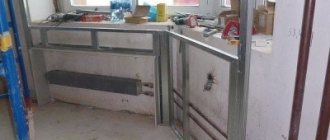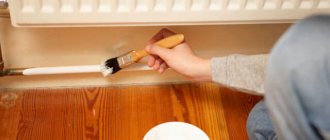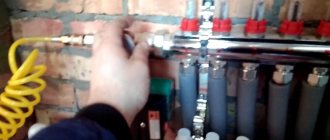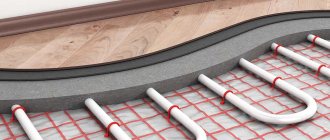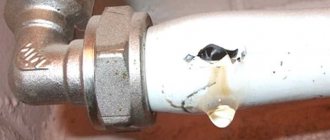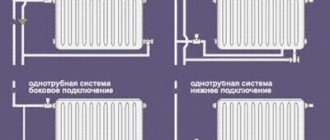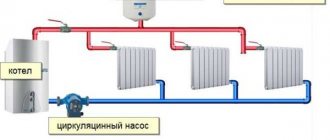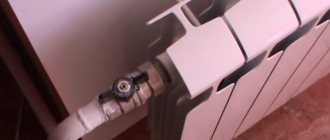When the system is recharged by a thermal device, some air appears in the radiator along with water. Often it is dissolved in the liquid, but in an area with low pressure it collects in the pipe. This creates an “air jam”; if it is not released, it creates serious interference with the circulation of warm water through the network. When topping up, the heating system cannot always dislodge these plugs with water.
The design of the Mayevsky tap is a manual air vent that improves the operation of the heating system. For example, it often happens that part of the network heats poorly or does not heat at all, although the boiler is operating at full capacity. This occurs due to airing of the battery, so warm water does not enter it. To bleed air from the system, you need a Mayevsky valve; its technical characteristics and simple operating principle make it possible to easily solve this problem.
For a long time, simple water taps were used to bleed air from the network, which were also used to draw warm water from radiators for domestic needs. For a closed heating system such actions are unacceptable. The Mayevsky faucet made it possible to change the situation; it is very easy to use, but taking water from the battery with this device is difficult.
Important! In the instructions and regulatory documents, which describe the operating principle and technical characteristics of the device, the name “Maevsky valve” is not found; instead, it is written “radiator needle air valve.”
How to bleed air from a radiator using an air vent
Valves will help bleed air from the radiators (they can be manual or automatic). Let's look at their types.
Mayevsky crane
A needle valve, the design of which includes a body and a cone-shaped screw - very tightly attached to each other, which helps prevent water leakage.
The faucet has a side hole that allows you to bleed air from the coolant using a screwdriver or a wrench from the kit (in some models, manually). When installing the Mayevsky tap, you need to ensure that the tube through which the air is removed looks straight down (but not into the wall!).
Note! For a cast iron radiator, you should choose an automatic air vent.
So, how do you bleed the air out of the radiator? Follow the following instructions:
- Take a wrench or a screwdriver, a rag and place some container under the tap.
- Turn off the pump.
- Begin to carefully turn the tap counterclockwise.
- The air from the radiator is unlikely to be clean.
- Close the tap after water flows from it.
Note! If the system uses low-quality water, then shut-off valves will not be superfluous. First, a valve is installed to prevent debris from accumulating, and then a tap is installed.
Automatic air vent
It helps to automatically bleed air from the coolant if it accumulates. The air vent has a brass body, float, articulated arm and valve. The locking cap is sealed, the spring-loaded protection does not allow debris into the system.
The operating principle of the system is as follows:
- Until it is necessary to bleed air from the radiator, the valve is covered with a float.
- In order to release air from the radiator, the float opens the valve.
- As the gas is removed, the air vent returns to its original position.
Remember! The automatic air vent has a hole for an octagonal wrench or screwdriver, through which, if a problem occurs, the air from the radiator can be vented manually.
Air separator
This device allows you to bleed air from radiators in stand-alone systems. An air separator removes gas accumulated in the system, converting it into bubbles. The device is used in conjunction with a sludge separator, which removes various pollutants from the water.
The system has the following form: a metal cylinder, on it there is an air vent, under it there is a valve for discharging sludge. In the inner part there is a metal mesh that creates vortex flows. Water passing through the system is filled with air bubbles, which rise and exit through the air vent. The remaining dirt is drained through the tap.
Knowing how to bleed air from the radiator will help prevent serious damage. Gas is also removed for “prevention”; this should be done twice (to make sure there is no gas). However, if there are malfunctions in the heating system, then you need to bleed the air from the coolant several times.
Read material on the topic: How to change a heating radiator without errors
The influence of air on the heating system
The functioning of the heating system is based on the circulation of heated water with the release of part of the heat into the radiators to heat the room. If air enters the internal part of the system (the process is called airing), a disruption in the circulation of the coolant occurs. The system responds to airing as follows:
- When the coolant circulates, noises are clearly audible, which not only creates discomfort for residents, but is also a symptom of pipeline vibration, as well as backlash in connections. In some cases, vibrations result in the destruction of welded joints with obvious unpleasant consequences.
- Air pockets form in the circuits. This happens especially often in non-residential premises where there is no regular temperature control. The result of traffic jams is defrosting the system.
- Deterioration of circulation or its complete cessation. Under conditions of slow circulation, the efficiency of the system decreases and fuel consumption increases.
- The development of corrosion processes as a consequence of air penetration into internal metal parts. The result of corrosion is a reduction in the operating life of equipment.
Prevention
Experts recommend doing prophylaxis once a year. Typically this should happen at the beginning of the heating season. This is the only correct way to reliably avoid breakdowns and unnecessarily high heating costs.
For standardized heat exchangers, also called batteries, you need a small wrench with which you can open and close the vent valve. The diverter valve is located on the opposite side of the thermostat. For a heated towel rail in a bathroom, the valve is at the top (rear).
On the front part in the middle of the valve there is a square pin with which the element rotates. If the pin has a slot, you can also use a screwdriver instead of a square wrench. On the side of the valve is a small nipple or tube with a hole that allows water to flow out when opened.
If you have your own heating system or gas boiler in your apartment, you should turn off the circulation pump and wait one hour to allow any existing oxygen in the radiators to collect at the top. When the pump is turned on, it swirls in the system, reducing the likelihood of complete venting. If you cannot turn off the circulation pump yourself (for example, central heating), close the heating system of your apartment.
Once all heat exchangers have been ventilated, install the circulation pump again. If a lot of water is drained, the pressure in the heating system may decrease. If possible, check the pressure on the system gauge and, if necessary, increase the pressure by adding water.
There are several types of heating systems:
- manual. These devices are small in size and are installed on radiators indoors. It is enough to adjust them with a screwdriver or wrench. Due to low productivity, such air vents are used only for local removal within the apartment;
- automatic. Without outside interference. The devices are very effective, but very sensitive.
Bleeding air from heating devices
Before bleeding air from the radiator and from the system, you need to familiarize yourself with the features of this procedure and prepare tools and materials
It is important to understand how to bleed air from a battery correctly. You need to have a special key at your disposal that will help open the air valve on the battery. A radiator wrench is best suited for this type of work - you can buy it at a hardware store
A radiator wrench is best suited for this type of work - you can buy it at a hardware store.
If you have to work with a modern battery, then a simple screwdriver will do. You should also prepare a container for draining the coolant and several rags in case of an unforeseen situation.
Instructions for properly bleeding air from the battery look like this:
First, they inspect the battery and find a small valve (Maevsky tap). It is located at the top of the device; sometimes there are several such devices. Turn off the tap until air hisses.
You must act carefully and smoothly. Place a container under the valve
You should wait until all the accumulated air comes out. This is evidenced by a thin stream of water that has stopped bubbling.
According to some experts, you need to drain approximately 2 - 3 buckets after the coolant begins to drain without gases. This is necessary for reinsurance, so as not to carry out this procedure again. The valve is screwed back on.
In addition to the Mayevsky tap, you can bleed air from the battery using automated air vents. They are intended for heat supply systems and remove plugs independently.
These devices are compact and reliable, but care must be taken, because the valves are unattended and even a slight disruption of the process can lead to flooding of the basement or attic
Sometimes situations arise when, during the installation of the heating system, special products designed to eliminate air pollution were not installed. To release excess air from the device, you need a gas or adjustable wrench to unscrew the plug.
This work needs to be done slowly. If the plug does not unscrew, and such situations most often occur with cast iron radiators, a special lubricant should be applied to the threads. After a while the attempt is repeated. After you have managed to unscrew the plug, proceed in exactly the same way as with a regular tap.
At the end of the work, the plug is returned to its place, not forgetting to wrap flax or FUM tape around the thread, which will prevent leaks and ensure the tightness of the connection.
If air has collected in the heating system of a private house, the coolant is drained using an expansion tank. This container is located at the highest point of the heat supply structure. After draining the water, wait a little, then unscrew the tap on the tank.
As a rule, when the temperature in the battery rises, the plug is removed on its own. If the above actions are unsuccessful, then the water in the heating circuit must be brought to a boil and then the air will certainly escape.
Knowing how to bleed air from the radiator and system, you can avoid many problems. For preventive purposes, a similar procedure should be carried out before the start of the heating season. According to experts, two times (for verification and control) will be enough. If defects or breakdowns are found in the structure, then the number of descents may be greater.
Humidifiers
During the heating period, it is recommended to maintain the indoor humidity necessary for normal living. For this you need humidifiers.
You can make them yourself. There is a lot of information on the Internet to implement this idea. Otherwise, radiator-mounted air humidifiers can be purchased and installed yourself. You can find out how to bleed air from the battery by following this link.
What to pay attention to
Each heat exchanger has a release valve, which is usually located in the upper left or upper right corner of the heater. Install the key and turn counterclockwise. You must be slow and careful as there is pressure in the heating system. After a while, a hissing sound may appear. This means that air is being removed from the battery.
Water will start to come out of the heat exchanger, so you must remember to place a container or container underneath it. After a while, only water will come out of the valve. Then it should be turned back clockwise.
Those who have never done this themselves should pay special attention to safety: the water that comes out of the radiator can be very hot at some point. There is even a risk of scalding
Places of formation and elimination
It is necessary to bleed air from the battery if there is no doubt about its presence. Gasping is indicated by unexpected gurgling sounds. In addition, the owner begins to notice that the heating is uneven. To restore radiator circulation, air must be removed.
If the system is completely aired, first determine where the plugs are forming by tapping the pipes with a hammer. The sound is stronger and more sonorous in the places where the traffic jam occurs; the areas will also have a lower temperature. Having found a place with air, you need to do the following:
- Prepare a key or screwdriver, as well as a basin for water. The thermostat is opened to the maximum level, then the container is placed.
- Open the valve, making sure that all the water from the inside will flow into the substituted container. You can additionally place rags around.
- The valve must be kept open until all the liquid has drained. A slight hiss indicates air escaping. This means that the manipulations are performed correctly.
- If after the procedure the pipes still do not heat up well, then they need to be blown out and washed - the accumulation of rust inside can also cause air to appear.
What to do if there is air left
Sometimes after deflating the battery there is no necessary heating. You can fix the problem by blowing or washing the batteries.
You can fix the problem by thoroughly washing the battery.
With an autonomous system, it is necessary to check that it is completely filled. If the coolant is water, then expansion occurs quite quickly. When temperatures drop, water shortages occur.
If there is a need to drain water through the tank, it is necessary to disconnect the home from heating. The valves are pre-opened.
When the temperature rises, the plug comes out. If this does not happen, you need to boil the water. After this, the air will certainly come out.
How long do you need to bleed the batteries?
The duration of the procedure is determined individually. It all depends on the scheme, type of heating, degree of airing. Usually the process is considered complete when the air stops hissing from the tap and the water flows in a steady stream.
The deaeration process is considered complete when water flows steadily from the tap.
To confidently remove the air lock in the heating battery, drain 3 buckets of water through the tap. With this amount of coolant, all the air is guaranteed to escape.
What and how to bleed air from a heating radiator
In order to control the gas contamination of the system both in an apartment and in a private house, use a manual or automatic air release valve. They should be discussed in more detail.
- Automatic air valve;
- Air separator;
- Mayevsky crane.
The automatic air valve is capable of independently releasing air that has accumulated in the radiator. It consists of a brass body, float, articulated arm and valve. A special cap protects against leakage, and the protection located under the spring protects against the ingress of external contaminants.
The system works on the following principle:
- While there is no air, the float keeps the valve closed;
- As gas accumulates, the float begins to descend and gradually open the valve;
- The accumulation of air leaves the compartments, and the system returns to its original state.
It is important to note the fact that all automatic versions are equipped with connectors that are suitable for a screwdriver or octagonal keys. Thanks to this shape, you can open the valve even in manual mode if the automatic mode suddenly breaks down
As for the air separator, this system is a little more complicated. The principle of its operation is to absorb air, turn it into bubbles and remove it out. Most often, separators are combined with sludge, which is capable of trapping dirt, sand or rust. If we talk about the design, it is presented in the form of a metal cylinder, which includes an air vent at the top and a valve at the bottom, which serves to discharge foreign contaminants. Inside such an installation there is a mesh that creates a vortex flow.
The same method is used when there is a water circuit that is connected to heating. The release in the water supply is carried out as a bleed. That is, a stream of air or water with impurities can be released through the bleeder.
Bottom filling with user access
A distinctive feature of the bottom filling is the pairwise connection of heating risers. In this scheme, the supply and return bottlings are located in the basement of the building, and valves are located between them with risers. Either plugs or taps are installed behind the valves, allowing water to be drained if necessary.
During lower filling, the air present in the risers of the system is squeezed out into the upper sections of the risers connected in pairs. On the top floor (usually in apartments, but sometimes in the attic) there is a jumper between the risers, near which a Mayevsky valve is installed, which allows air to bleed from the system.
First of all, residents of apartments on the upper floors need to know how to remove an air lock from a heating system:
- The tap turns 180 degrees and air begins to hiss out of it;
- When water starts flowing from the radiator, the tap must be closed.
When living on any other floor, it will be enough to ask the neighbors above to bleed the air in their free time. If for some reason it is not possible to come to an agreement with the neighbors, you will need to submit an appropriate application to the local housing organization. The main thing is to ensure that the application is accepted in accordance with all the rules, and then if problems arise with heating, it will be possible to request a recalculation in the future.
Bleeding air from heating radiators
Before bleeding air from the radiator and from the system, you need to familiarize yourself with the features of this procedure and prepare tools and materials
It is important to understand how to bleed air from a battery correctly. You need to have a special key at your disposal that will help open the air valve on the battery
A radiator wrench is best suited for this type of work - you can buy it at a hardware store.
If you have to work with a modern battery, then a simple screwdriver will do. You should also prepare a container for draining the coolant and several rags in case of an unforeseen situation.
Instructions for properly bleeding the battery:
First, they inspect the battery and find a small valve (Maevsky tap). It is located at the top of the device; sometimes there are several such devices. Turn off the tap until air hisses.
You must act carefully and smoothly. Place a container under the valve. You should wait until all the accumulated air comes out. This is evidenced by a thin stream of water that has stopped bubbling.
According to some experts, you need to drain approximately 2 - 3 buckets after the coolant begins to drain without gases. This is necessary for reinsurance, so as not to carry out this procedure again. The valve is screwed back on.
In addition to the Mayevsky tap, you can bleed air from the battery using automated air vents. They are intended for heat supply systems and remove plugs independently.
These devices are compact and reliable, but care must be taken, because the valves are unattended, and even a slight disruption of the process can lead to flooding of the basement or attic.
Sometimes situations arise when, during the installation of the heating system, special products designed to eliminate air pollution were not installed. To release excess air from the device, you need a gas or adjustable wrench to unscrew the plug.
This work needs to be done slowly. If the plug does not unscrew, and such situations most often occur with cast iron radiators, a special lubricant should be applied to the threads. After a while the attempt is repeated. After you have managed to unscrew the plug, proceed in exactly the same way as with a regular tap.
At the end of the work, the plug is returned to its place, not forgetting to wrap flax or FUM tape around the thread, which will prevent leaks and ensure the tightness of the connection.
If air has collected in the heating system of a private house, the coolant is drained using an expansion tank. This container is located at the highest point of the heat supply structure. After draining the water, you should wait a little, then unscrew the tap on the tank.
As a rule, when the temperature in the battery rises, the air lock is removed on its own. If the above actions are unsuccessful, then the water in the heating circuit must be brought to a boil and then the air will certainly escape.
Knowing how to bleed air from the radiator and system, you can avoid many problems. For preventive purposes, a similar procedure should be carried out before the start of the heating season. According to experts, two times (for verification and control) will be enough. If defects or breakdowns are found in the structure, then the number of descents may be greater.
Causes
Residents of high-rise buildings had to deal with an unpleasant situation when the heat on the top floors did not reach them at the start of the heating season . There are several reasons for air congestion:
- repair work, such as pipeline dismantling;
- during installation, the slope directions and dimensions of the pipelines were not observed;
- low pressure;
- error when filling the heating system;
- poor sealing of joints - coolant leaks through them;
- connection to underfloor heating;
- malfunction of air intake devices.
In this video you will learn how to remove air from a radiator:
If you live in a private house, you shouldn’t worry too much about a little airiness in the system. The coolant in it is rarely changed, therefore, the air bleeds out on its own after one or two days.
How can you avoid the formation of an air lock?
How can you remove air?
The ideal option is when, during installation of the heating system, a special Mayevsky valve is built into each radiator, with which you can bleed air from each radiator separately.
You can also use an automatic air vent, which will autonomously control the entire heating system. Even with a perfectly functioning heating system, you will still have to periodically bleed the air from the batteries, but this will not cause much difficulty.
While filling the system, try to control the water pressure and temperature of the radiators. If suddenly the water pressure begins to drop sharply, it means that the seal of the battery has been broken somewhere. If the temperature of the batteries is not stable, look for an air lock in the heating system.
If your batteries are equipped with automatic air vents, then you can rest easy: they will do all the necessary work for you to eliminate air from the radiators. If the batteries are equipped with small manual taps, then you need to carry out the entire procedure for removing air from the heating radiator yourself.
Another important point is the pipeline itself. Quite often, an air lock can form in very difficult places in the pipeline, where there are many bends, turns or incorrect slopes. In such areas it is necessary to install additional air vents.
How to bleed air from a battery?
In order to remove air from the battery, you need to use a special Mayevsky tap, which is designed specifically for this.
Prepare a bucket for water in advance. In the upper right corner of the radiator you will find the Mayevsky tap, which must be unscrewed with a special key or a regular screwdriver. Don't forget to place a container where the water will drain.
Listen to the sounds that the battery makes: first you will hear a slight hissing sound, which indicates that there is indeed air in the battery, which means that you are doing everything correctly. Now water should drip from the battery, wait until the water runs in a thin stream and screw the tap into place.
There are times when eliminating the air lock in the batteries did not bring any results, and the radiators still remain cold, then it is necessary to thoroughly rinse and blow out the battery.
If this procedure does not yield anything, you need to look for the problem in the heating system itself.
We hope that the material was useful to you. If it’s not too much trouble, please click the social media buttons so that others can read this article.
Have a nice day!
What is an air valve?
The air valve for heating is a sealed cone-shaped or cylindrical body made of brass. Inside it is a hollow float made of Teflon or polypropylene. This float is connected by a lever to the drain valve, which is equipped with a locking plug. This plug prevents coolant leakage if the device breaks down.
Now, once and for all, without any registrations or SMS, you can download 1xBet for Android for free by clicking on the active link and continue to enjoy the game and place bets on your favorite team in a convenient mobile application.
Air vents for heating systems come in three types:
- Direct devices of traditional type. They are mounted only vertically.
- Corner type devices that are installed at right angles. They are mounted on radiators instead of Mayevsky taps or in the event that a direct type of air vent cannot be installed.
- Special models for installation on radiators.
According to the principle of operation, the air vent can be manual (Maevsky tap) or automatic. The last variety is the float-type devices described above.
Operating principle of manual valve
Let's figure out how a manual air bleeder for a heating system works. To understand the structure of this type, you need to look at the drawing of the Mayevsky crane. At the end of the brass body with external thread there is a hole with a diameter of 2 mm. It is covered by a screw with a cone tip. On the side of the same body there is a hole of a smaller diameter, which is used to bleed air.
The operating principle of a manual air vent is as follows:
- In operating mode of the heating circuit, the shut-off screw is tightly tightened. The outlet is hermetically sealed with a cone.
- To release the air lock, the screw is unscrewed a couple of turns. As a result of coolant pressure, air begins to escape through a small hole, then enters the outlet channel and is discharged outside.
- Moreover, at first only air comes out of the hole, then an admixture of water appears. The tap must be closed when only a stream of water flows from the hole.
Because there are no moving parts to clog, rust, or wear out, a manual air vent is a reliable, trouble-free device. This valve is installed only on radiators.
Manual type valves are divided into the following types according to the method of unscrewing:
- a metal or plastic handle is used for opening;
- More often you can find a slot for a screwdriver with a flat working blade;
- To unscrew it with a special key, there is a screw with a tetrahedral tip.
Operating principle of automatic valve
The automatic air collector for the heating system works without human intervention. It is essentially a vertical brass cylinder with threads and a plastic float inside. The float is connected by means of a lever to the air release valve pressed by a spring. This valve is built into the lid.
The operating principle of an automatic air vent in a heating system is as follows:
- When the heating system is operating, the internal chamber of the device is filled with water, which presses the float up. As a result, the air valve is pressed by a spring and tightly closed.
- When air accumulates in the upper part of the chamber, the level of the coolant decreases, which causes the float to lower.
- When the liquid level drops to a critical value under the weight of the float, the spring compresses and opens the valve. As a result, the air begins to bleed out.
- Due to the increased coolant pressure in the system, all air is displaced from the chamber of the device. The liquid takes the place of the displaced air and causes the float to rise, which pushes the valve up and tightly closes the hole.
While the network is being filled with coolant, air pockets are constantly being bled off, since the float lies at the bottom of the container. When water fills the chamber, a spring mechanism raises the valve. As a result, the bleeding process stops. However, some oxygen remains in the housing under the cover, but this in no way affects the operation of the heating circuit.
Automatic devices come with angular and direct connection. The latter type discharges vertically, and the first - to the side. The corner version is valued for its reliability, but collects air bubbles worse.
Application of the Mayevsky crane
Air can be released using special removable handles. They are put on the inside of the valve, which is made of metal. If such a handle is missing, it must be replaced with a notch for a screwdriver.
Mayevsky crane - a convenient device
How to properly remove air from a heating system?
- Place a container under the tap (volume – 500-1000 ml).
- Open the tap. Wait until the air comes out. Then a characteristic hiss will appear, indicating the flow of air mixed with water.
- Wait until clean water comes out.
- Close the tap.
If there is no handle, you will need to use a screwdriver or wrench. You can use a gas or adjustable wrench
If the tap is screwed on very tightly, you need to act carefully. Otherwise, you can rip it off, the consequences of which can be catastrophic.
The instructions are:
- Wrap the surface of the radiator. Use a rag or rags. Place a container to allow liquid to drain out.
- Turn off the tap and wait for the hiss to appear.
- Wait for the water to drain out.
- Drain the water (up to 2000 ml).
- Turn on the tap.
- Wait 10-12 minutes.
- Turn off the tap and make sure that the air comes out completely.
- If this does not happen, you need to repeat the procedure.
Battery plug
If there is no tap, and instead there is a Soviet-style plug, you need to proceed as follows:
- Wrap the desired area with thick fabric. You can use rags. This will eliminate the risk of high pressure.
- “Arm yourself” with a converter (can be replaced with a solvent).
- Carefully turn the plug. There is no need to take it out completely, otherwise there will be a “flood” in the apartment.
- Wait for the air masses to come out. The flow can be felt by placing your hand near the plug.
- Wait until the water flows out (3000-5000 ml).
- “Arm yourself” with fum tape and wrap the plug. The required direction is against the thread. This provides the necessary tightness.
- Screw the plug as tightly as possible.
For individual heating, you can use an expansion tank
If your home has individual heating, you can get rid of the problem using an expansion tank. They can be open or closed.
In the first case, we may be talking about a decrease in the coolant or water level. They should be added to the system. It is advisable to use the bottom valve. The radiator can be absolutely anything. If this is not possible, you will need to use a tank.
After removing the air lock, it is necessary to start the system. She should do a good job. If the plug remains, it is drained using the radiator.
If the type of tank is closed, then you first need to check its functionality.
Types of automatic air vents
Automatic air vents are available in the following types:
The straight lines that we met in the very first pictures, I’ll show them again:
Angular ones, which are often installed on radiators instead of the Mayevsky tap:
Radiator plugs having the same thread as radiator plugs:
As you know, Mayevsky valves are designed to bleed air from the system through the radiator. This bleeding is performed manually as an air plug forms in the radiator, which is easy to determine by touching the radiator with your hand... Installing a radiator air vent frees you from such work, since the air will be removed automatically.
However, no matter what the air vent looks like, they work on the same principle.

